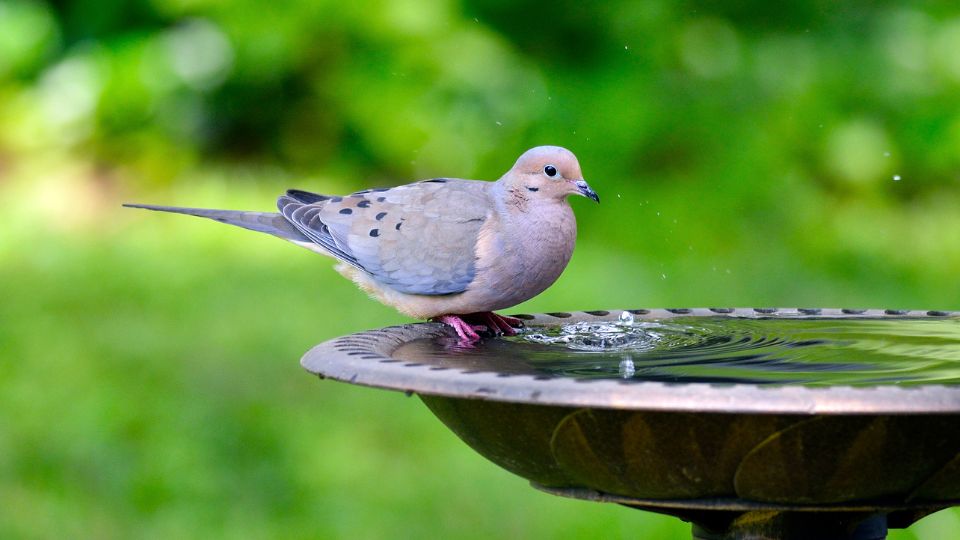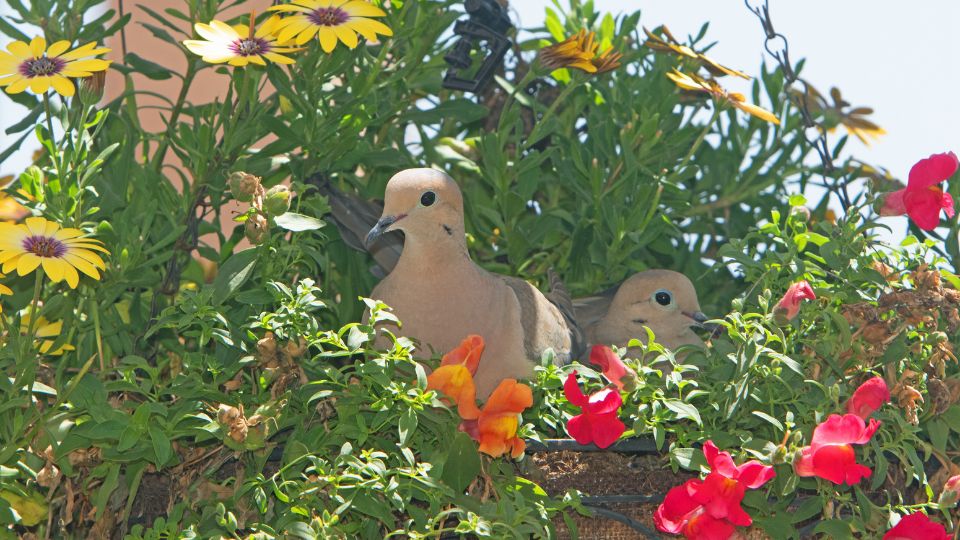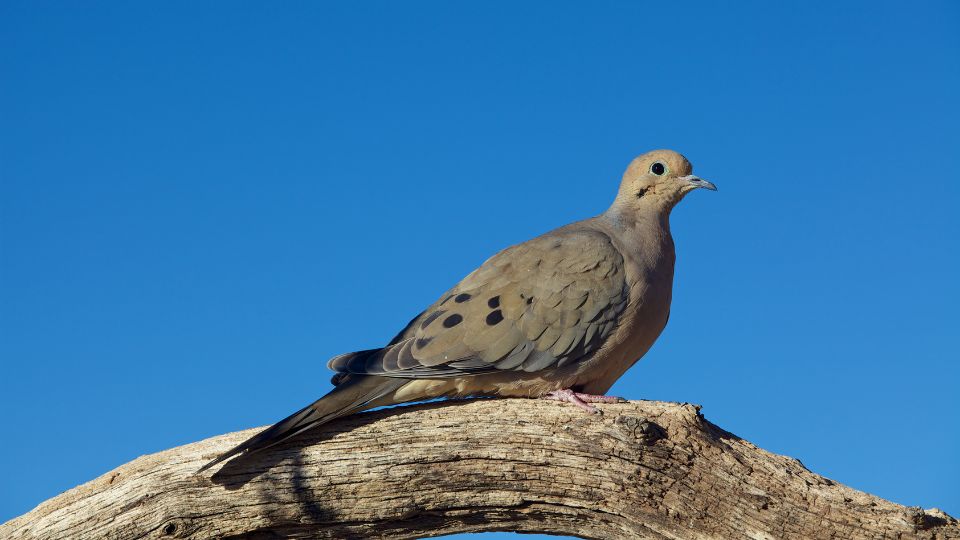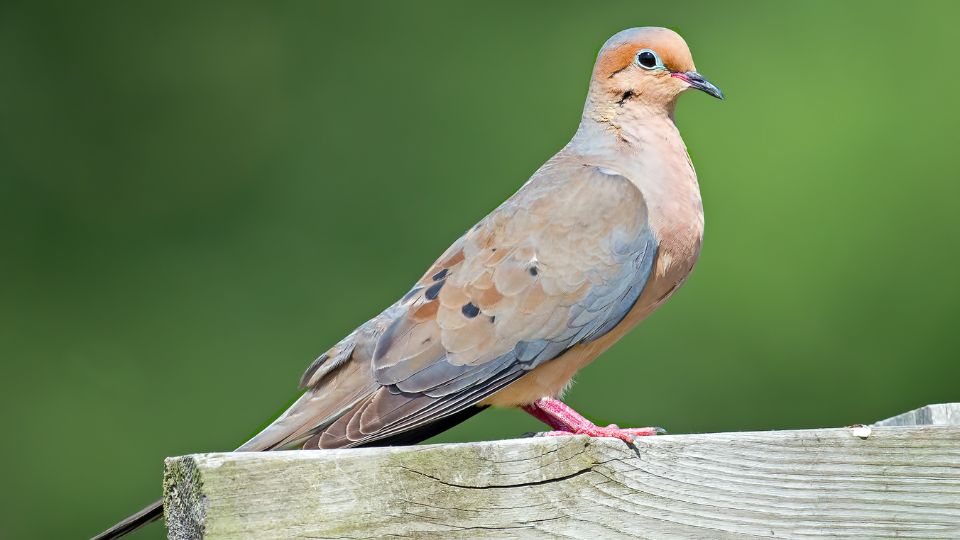Doves in the wild have an average lifespan of 1.5 years. There are several species of wild dove in the United States. Species of doves found in North America include collared, ringneck, white-winged, and mourning doves.
Experts have spent countless hours in the field examining how natural predators and humans are responsible for the lifespan of the dove bird. Wild doves have one of the shortest lifespans compared to other bird species.
Despite their large population and ability to adapt to different climates and habitats, only 25% of doves survive their first year of life. Of the doves that survive their first year, only 60% make it to 1.5 years old.
What is behind this startlingly short dove lifespan? And why do captive doves live over 12 times longer than wild doves? First, let’s look at common questions about the wild dove’s lifespan.
How long do doves live in the wild?
On average, doves live to about 1.5 years. Of all the wild birds in North America, doves have the shortest lifespan for their size. Seventy-five percent of doves fail to make it beyond their first year of life.
The doves that do survive their first year will have 40% chance of survival beyond 1.5 years. Less than 10% of doves survive to the end of their typical wild lifespan, which is five years. In contrast, a captive dove has an average lifespan of 19 years.

The most common dove species is the mourning dove (Zenaida macroura). Mourning doves nest and dwell throughout North America, with large populations living year-round from Mexico into Canada.
During the breeding season, the mourning dove can be found nesting as far north as Alaska. In the winter, this migratory bird is known to make its way as far south as Central America.
How long do doves live in captivity?
The average lifespan for a captive dove is 19 years. Some captive doves are housed 100% of their day in large avian enclosures called aviaries. Other captive birds are kept in at night and allowed to roam during the day.
Aviaries are structures large enough to comfortably hold several birds with space to fly, nest, and socialize. Wire mesh with small openings prevents predators from accessing the doves, keeping them safe.
Captive doves that are free roaming during part of the day are fitted with a small metal band around their leg. Different keepers use a variety of colors, numbers, and other symbols to identify birds in their flocks.
Leg bands let hunters know these are not game birds. Keeping the doves enclosed from dusk until dawn protects them from nocturnal predators. Dove keepers still lose some of their flock but protecting doves in their first year and at night when they’re most vulnerable increases their lifespan dramatically.
Why do wild mourning doves have such a short lifespan?
Wild doves have a short lifespan due to predators and other dangers they face in their first year of life. Predators are the single biggest factor in the short dove lifespan.
Doves nest on or near the ground, which makes the parents and nestlings easy targets for foxes, raccoons, bobcats, squirrels, snakes, cats, skunks, and even dogs. Flighty and focused primarily on survival, doves will abandon a nest at the slightest sign of danger. This leaves eggs and even nestlings unprotected from the many natural hazards doves face.
Trichomoniasis carried by snails is another danger in the dove’s natural habitat. Doves sometimes eat snails, which are typically harmless and a good source of calcium for doves. Some snails can carry trichomoniasis, which is a parasitic protozoan disease.
The disease causes obstructive growths in the dove’s crop. Since young mourning doves are fed via crop milk, one dove infected with trichomoniasis can kill an entire nest.

But it isn’t only natural hazards that plague the dove. Like many wild birds, hundreds of thousands of doves nationwide are killed by outdoor cats each year.
Mourning doves are the most anundamt species of dove in North America. They are also called turtle doves. One unique factor in the short lifespan of mourning doves is human hunting.
According to the US Fish and Wildlife Service, an estimated 24 million adult mourning doves are killed by hunters each year. A popular game bird, most mourning doves, are hunted purely for sport.
Despite all the challenges they face and their relatively short lifespan, doves are designated as of least concern by conservationists. There are about 400 million doves in the United States. Approximately 350 million of those doves are mourning doves.
Do doves come back to the same nest every year?
Doves will return to familiar nesting sites but build new nests every breeding season. Doves mate for life, and mating pairs work together to build nests. Male mourning doves will collect pine needles, sticks, and various items. Most of the actual building of the nest falls on the female mourning dove.
Mourning dove nests are flimsy and don’t always hold up during the 14-16 day incubation period. While a nest can last through the two to three broods doves average each mating season, doves often abandon nests and rebuild near the original nesting site.
Despite being attentive parents who share feeding and rearing responsibilities, doves are easily frightened away from their brood. If the parents are startled, they may knock the eggs or nestlings out of the nest, leaving young mourning doves exposed to the elements and predators.
Do doves have any predators?
Falcons, foxes, raccoons, bobcats, and skunks are all-natural predators of the dove.
Natural predators
Doves are in constant danger from natural predators both by air and by land. Falcons are often seen feeding on doves and pigeons, snatching them out of the air in the blink of an eye.
A diving falcon can and will reach speeds of up to 200 miles per hour. While mourning doves have been recorded flying up to 55 miles per hour, that’s nothing compared to the speed of a falcon. Up to 99% of a falcon’s diet comprises other birds. A single falcon can eat up to one dove a day.
Foxes, raccoons, bobcats, and skunks hunt at night, creating another hazard for doves and their hatchlings. Doves nest on or near the ground, leaving the attending parent and nestlings vulnerable to wild predators.
Doves are skittish and will leave the nest if frightened. This means an easy meal for egg lovers like skunks, foxes, and raccoons.
Humans
Humans are directly responsible for the short dove lifespans. Climate change, housing developments, poisons, and even death by colliding with windows contribute to the dove bird’s high mortality rate.
But mourning doves face a unique threat from humans that other songbirds do not. Sport hunting of mourning doves claims an estimated 24 million doves every year.
Mourning doves are the only North American bird considered both a songbird and gamebird. While some hunters use mourning doves for food, the vast majority of hunters go after this popular gamebird solely for sport.
Outdoor cats
Unsupervised outdoor cats are the biggest threat to mourning doves and other birds. Domestic cats are the number one threat to birds in the United States and Canada.
A staggering 2.4-3.7 billion birds are killed yearly by outdoor cats. Death by domestic cat far exceeds any other human-caused avian death.

What are the best ways to protect doves?
Deterring predators from your yard is the best way to protect doves. Remove food sources that attract predators, like uneaten pet food, rodents, and unsecured garbage. Rotate the bird feeder location and use a bird seed that doesn’t build up on the ground.
You can offer nesting boxes explicitly made for doves to protect doves from natural predators. Doves like open boxes close to the ground but will build a nest up to five feet off the ground. Doves have adapted well to urban areas and don’t mind human activity, so a dove nesting box affixed to a back porch or backyard shed is a great way to keep doves out of reach of ground dwelling predators.
Using stickers on your windows can help wild birds avoid deadly collisions. Avoiding poisons for pest control and lawn care will also improve wild dove life expectancy.
Keeping cats inside or on a leash while outside will significantly decrease the number of wild bird deaths. A patio is also an option, offering your feline friend sunshine and fresh air while protecting wildlife.
Protecting doves from predators and human-caused deaths in their natural habitat will increase the life expectancy of wild doves, even though it won’t remove all threats entirely. Doves, by nature, are vulnerable to predators and diseases such as trichomoniasis, especially in their first year.
Captivity is the only way to prevent predator and human-influenced deaths but taking steps to protect wild doves in your backyard will give them a better chance of a much longer life.

